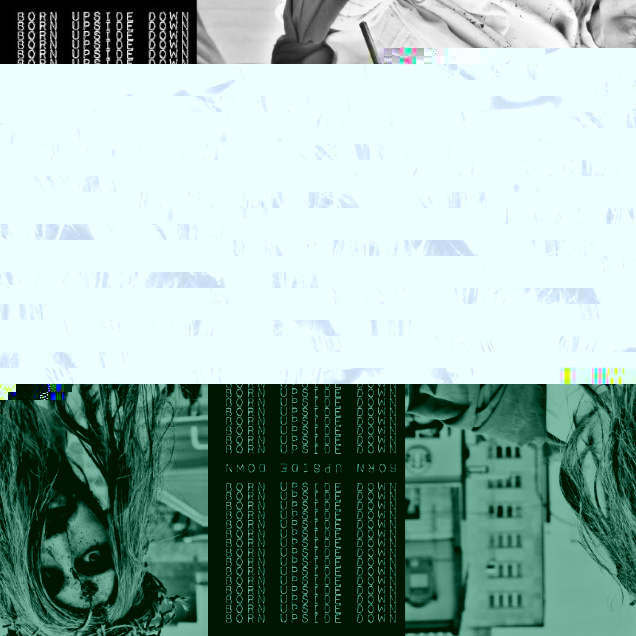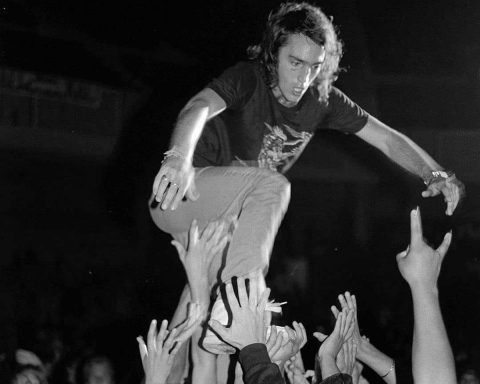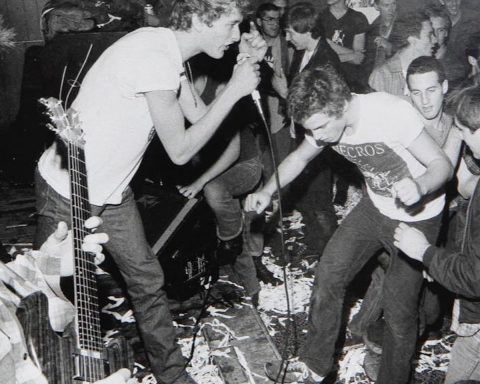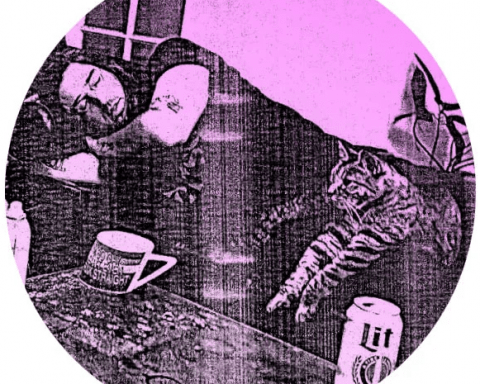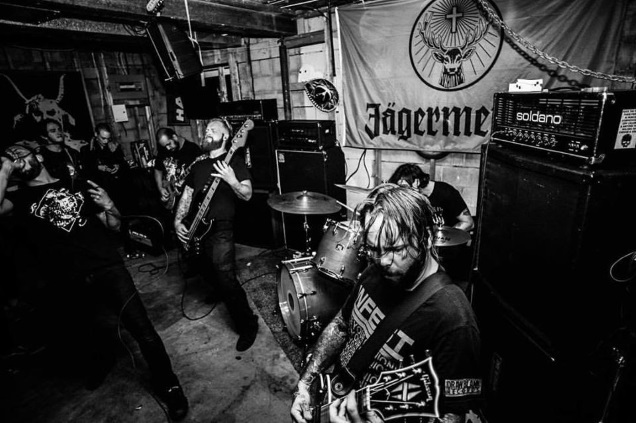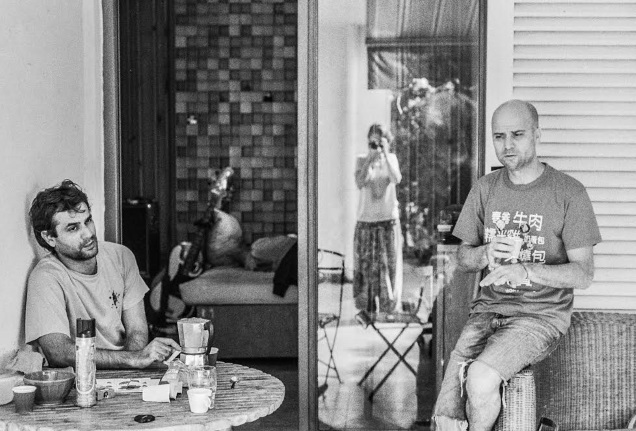Apart from loads of new record features and tons of interviews with musicians from all over the world, we look into how artists of many reative disciplines outside music engage with their medium and reflect on the world around us. I had the pleasure of spending some time with photographer Becky DiGiglio and lyricist / musician Justin Pearson (THE LOCUST, Three One G Records, DEAD CROSS), who have recently published an interesting, eye-catching collaborative photo-zine called “Born Upside Down“, a collection of photographs and thought-provoking captions that “reveal the grime and rot of life in America”. Almost instantly intrigued by both its form and concept, we sat down to discuss the role of the publisher and the processes of constructing a photobook.
Born Upside Down, the newest 36 page print photo-zine by Becky DiGiglio and Justin Pearson is available now via Pioneers Press. Locust House author Adam Gnade introduced the project flawlessly by stating:
Sometimes the best art holds a mirror to our ugliness—and in that ugliness we see beauty. Becky DiGiglio and Justin Pearson’s collaborative art book, Born Upside Down, pairs photography (DiGiglio’s) and caption writing (Pearson’s) to reveal the grime and rot of life in America. Flying saucers and corpse saviors are set alongside ghosted structures and crumbling wasteland. These blasted-out desert towns, decaying religious monuments, and haunted statues feel like life in Trump’s America—precarious, faulty, gothic, and doomed.
DiGiglio’s work here has a solitary, bare, quiet tone—life after detonation, abandoned dreams and hopes, desolation in the sand-flats and nothing but the bones, forgotten signs with peeling and chipped paint, and bent metal. Pearson’s captions are par for the course (“From here on out, let’s just swim in the sea section of casual bacteria” or “And since we‘re god, we might as well try to be better at it.“) DiGiglio’s music photography, often featuring Pearson’s bands Retox, Head Wound City, and Dead Cross, shows the power of violent catharsis in wildly communal settings but here the people do not come together; they do not gather and they do not rise or heal.
Continued below…
Says DiGiglio, “The few pages that seem to show interaction (the Dillinger Escape Plan photo of all the grabbing hands or the fly/spider) have a more predatory vibe than anything. Anything else that includes bodies are in the form of statues, and are pieces of a whole (a face missing a nose, or a skeleton, or a body without its head).”
Regardless of the severe content it’s hard not to see beauty in these pages. The windswept skies with tufts of white cloud, the stark contrast, the deep oceans of black, and the startling vibrancy of red blood splashed across a dirty toilet. In the face of ruin and devastation, it’s a beauty most won’t see but, for those with the right kind of heart and background, this work will call your name in rising swells. Ugliness and beauty are of course not mutually exclusive. As says Pearson in one of DiGiglio’s photo captions, “Life can be both cruel and beautiful.”
Continued below…
Hi Becky! Hey Justin! Thanks so much for joining us here on IDIOTEQ. How are you? How’s California?
Becky: Hi there! I’m reasonably well. California is good. I’m waiting for it to secede from the rest of the country… then it’d be great.
Justin: This project was really mainly Becky’s thing. She had asked me to collaborate with her on some sort of publication in relation to her photography and somehow this is what came about. I’ve been a huge fan of her photography for years and when she asked me to add captions to her photo-zine, I was honored to take part.
Ok, so please tell us a bit about this project. Why did you decide to make a paper zine, especially in our digital times? With the emergence of digital images, what role does it play for you these days?
Becky: I’ve always been more a fan of tangible things when it comes to art. I know that Justin relates, what with running Three One G and releasing rad vinyl in the age of digital downloads. I get the convenience of being able to have things really easily accessible to you, but I think taking in art, visual art in particular, should be a different experience, at least in some instances.
Obviously, scrolling through pictures on Instagram isn’t going to be the same as sitting down with a book (or, in this case, a zine) and really looking at/thinking about the images and the words that go with them. Allowing yourself to focus and creating a sense of isolation, separate from all of the other distractions that pop up when using technology, is important. Paying attention to all of the details of the photo that aren’t noticed when it’s just 2 inches by 2 inches as seen through a cracked iPhone screen seems more meaningful.
So yeah, although digital images are much more commonly what I work with (because that’s the most cost effective way of getting my work out to the public), I think there is worth in putting together something beyond that. And a hardcover coffee table style book of photography just isn’t logical or possible financially, nor is it really my style; the DIY ethics behind zines seemed like a good fit for how I approach photography. Nothing too fancy. Luckily, our friends at Pioneers Press release rad zines all the time, so it made sense to combine forces.
Speaking of zines in general, have you been into punk zines? Do you think there’s a resurgence of zine creators these days? How would you comment on the evolution of this unique form of publication?
Becky: It’s funny; I realized that I’ve been making zines since I was a kid. When I was 5-6 years old, I repeatedly made this zine called “Kid’s Stuff Magazine”. The title was ironic because the contents of it were not at all “kid stuff”, as it mostly centered around my drawings of The Crypt Keeper, whom I was obsessed with, as well as Pumpkinhead and other horror figures. I remember one drawing I did where there were body parts hanging from ceilings, and vampires. The sort of stuff you’d look at now and ask me, “Are you a serial killer? Because that looks like something a serial killer would draw as a kid.” (I can assure you, I’m not.) Then, the next page would be a cut and pasted image of something I saw from a Sharper Image catalog that I liked. It was so weird.
Anyway, what I’m saying is, I guess I’ve always been drawn to the style of zines, the sort of haphazard way about them, and I guess what I used to make was sort of punk, for a five year old. Hah!
I’ve always picked zines up along the way, if I see one that catches my eye in a bookstore or wherever. JP and I went to the San Diego Zine Fest last year, and it was rad to see so many people creating such diverse pieces in all different styles and on all topics. I hope to have Born Upside Down there this year. I also remember in particular going to Atomic Books in Baltimore and being fascinated by their selection, buying a few.
I don’t know that there’s a resurgence of zines these days; I think they’ve always been around, although not always very accessible, which goes along with the nature of them– if you’re making them yourself, from your own means, you’re not going to be able to make many or easily distribute them too much. There’s something special about that. I guess another way to distribute them now on a larger scale would be to make some sort of digital format.
I don’t necessarily see my release, Born Upside Down, as a zine in the traditional aesthetic sense, in that it seems pretty polished looking to me, and my stereotypical image of the zines I’ve grown up reading were not quite like that. But I do think the ethics are there (as I mentioned before), and it fits the category, because it is such a diverse one.
Whooo, incredible. I hope you don’t mind my asking, but are you a serial killer? Haha! ;)
Ok, so jumping into the details of ‘Born Upside Down’, where did the title come from?
Justin: I’ll jump in here since I came up with the text for the project. I had this idea of birth being evil, human birth that is, in relationship to the planet we live on. Yes, there are good humans here, but we as a species are a disease to mother nature as well as the rest of the animals on the planet. So there was this “evil” context be being born upside down, like the imagery of an upside down crucifix. The irony of it all is that we are technically born upside down when we exit the womb. So there you have it. After the fact, Becky pointed out that it’s a lyric to a track off of David Bowie’s “Black Star”. So apparently I’m not that original. To my credit though, I had been sitting on that line and concept behind it for some time, among the arsenal of stuff I compile for lyric writing.
How do these photographs link to this concept? What would a good shot need to find its place within this collection?
Justin: I’m not sure who can answer this best to be honest. As far as the text and my over all contribution, I do feel this project was more of Becky’s thing than mine. She had a general idea of what photos would fit in a zine that seemed like a collection or a group that was somehow related. So the photos were presented to me, and in some sort of order, then I just added text, vaguely trying to stream the captions together. However, it’s a bit disjointed at times, but that is really how life is.

Becky: I think that given JP’s summary of how he came up with the title, coupled with the words he wrote, that the images will speak for themselves in terms of how they fit into the concept. I will say that we talked about the idea of only focusing on humans on the front and back covers, with everything in between showing mostly desolate looking scenes- images of destruction or abandonment. There are two images in there that do show interaction between living things, and these are more predatory in nature. One is a spider eating a fly, and the second is a bunch of hands grabbing at an anonymous arm (it is actually Liam’s arm, from DILLINGER ESCAPE PLAN) in an almost zombie-like, inhuman way. So I certainly think everything in the book speaks to our nature, or ties into that concept of the negative impact humans have, though they are intentionally absent from most of the content of the book.

How do you feel about the state of the world today and the evolution of humankind and society? Do you think humans are ultimately evil by nature or or incapable of defying our dark side?
Becky: What evolution? Just kidding, but only sort of. Yes, I think humans have evolved in certain ways, such as technological advancements and the stuff we are aware of. But as far as behavior goes, I think humankind essentially stays the same. There is a cyclical nature to our patterns. Maybe we will overcome (for the most part) one sort of prejudice or bias that we’ve picked up along the way for who knows what reason, but then there is always something new to replace that hatred. The fear of the other seems to be what manifests itself as “evil” behavior in society time and time again. That, and the need for omnipotence among egomaniacs (see: #45).
That said, no, I don’t think humans are ultimately evil by nature. For one, what is “evil”? Who determines what is or isn’t an “evil” act? Some might say abortion is evil, while others might say a cop murdering an unarmed black man in the street without fear of consequences is. It’s a man-made concept that varies greatly depending on who you ask, your culture, your class, etc.But I think it’s safe to agree that all humans have vices, and take part in destructive behaviors; it’s ingrained in us. Some try to fight it, but no one’s hands are totally clean. By the same token, there is “good” in everyone, too. I work with people for a living– I teach. I’ve worked with just about every population of person you could think of in some capacity, and I see daily that we are incredibly multifaceted beings, capable of “good” and “bad” on any given day.
With all this in mind, I’d still say that humanity as a whole is destroying the earth, and inevitably will destroy ourselves. I don’t think there’s any way around that. A lot of it is unintentional, or due to apathy, which is so frustrating and sad.

So how can we escape or outgrow, as Carl Jung called it, our shadows?
Becky: If I had the answer to that, I’d probably be releasing a different sort of book, and a lot more people would be buying it. I suppose to outgrow something, we have to acknowledge that it’s there to begin with, which is more than a lot of people are willing to do.
Alright Becky. Thanks so much for your thoughts. Thanks Justin! Please drop you final words with some teasers of your future projects and plans for the rest of the year, and take care! It’s been a pleasure having you here.
Justin: Thank you so much for asking such great questions.
Becky: Yes, thank you for everything!



